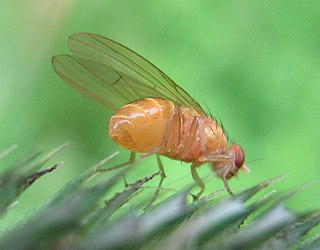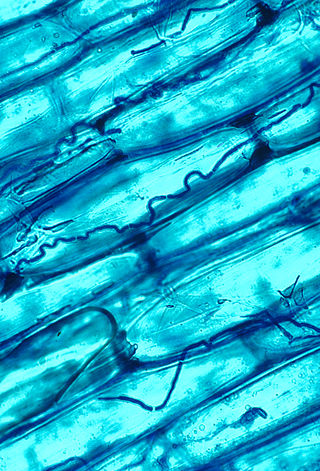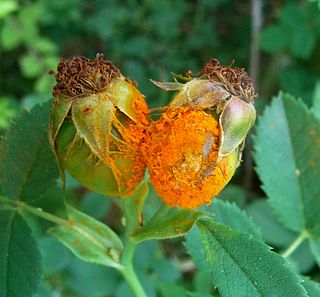
Biology – The natural science that studies life. Areas of focus include structure, function, growth, origin, evolution, distribution, and taxonomy.

A herbivore is an animal anatomically and physiologically evolved to feed on plants, especially upon vascular tissues such as foliage, fruits or seeds, as the main component of its diet. These more broadly also encompass animals that eat non-vascular autotrophs such as mosses, algae and lichens, but do not include those feeding on decomposed plant matters.

Genetic diversity is the total number of genetic characteristics in the genetic makeup of a species. It ranges widely, from the number of species to differences within species, and can be correlated to the span of survival for a species. It is distinguished from genetic variability, which describes the tendency of genetic characteristics to vary.
Backcrossing is a crossing of a hybrid with one of its parents or an individual genetically similar to its parent, to achieve offspring with a genetic identity closer to that of the parent. It is used in horticulture, animal breeding, and production of gene knockout organisms.
The diversity of species and genes in ecological communities affects the functioning of these communities. These ecological effects of biodiversity in turn are affected by both climate change through enhanced greenhouse gases, aerosols and loss of land cover, and biological diversity, causing a rapid loss of biodiversity and extinctions of species and local populations. The current rate of extinction is sometimes considered a mass extinction, with current species extinction rates on the order of 100 to 1000 times as high as in the past.
Genetic architecture is the underlying genetic basis of a phenotypic trait and its variational properties. Phenotypic variation for quantitative traits is, at the most basic level, the result of the segregation of alleles at quantitative trait loci (QTL). Environmental factors and other external influences can also play a role in phenotypic variation. Genetic architecture is a broad term that can be described for any given individual based on information regarding gene and allele number, the distribution of allelic and mutational effects, and patterns of pleiotropy, dominance, and epistasis.

In ecology, a community is a group or association of populations of two or more different species occupying the same geographical area at the same time, also known as a biocoenosis, biotic community, biological community, ecological community, or life assemblage. The term community has a variety of uses. In its simplest form it refers to groups of organisms in a specific place or time, for example, "the fish community of Lake Ontario before industrialization".

Urban wildlife is wildlife that can live or thrive in urban/suburban environments or around densely populated human settlements such as towns.

Avena barbata is a species of wild oat known by the common name slender wild oat. It has edible seeds. It is a diploidized autotetraploid grass (2n=4x=28). Its diploid ancestors are A. hirtula Lag. and A. wiestii Steud (2n=2x=14), which are considered Mediterranean and desert ecotypes, respectively, comprising a single species. A. wiestii and A. hirtula are widespread in the Mediterranean Basin, growing in mixed stands with A. barbata, though they are difficult to tell apart.
Island ecology is the study of island organisms and their interactions with each other and the environment. Islands account for nearly 1/6 of earth’s total land area, yet the ecology of island ecosystems is vastly different from that of mainland communities. Their isolation and high availability of empty niches lead to increased speciation. As a result, island ecosystems comprise 30% of the world’s biodiversity hotspots, 50% of marine tropical diversity, and some of the most unusual and rare species. Many species still remain unknown.
Host–parasite coevolution is a special case of coevolution, where a host and a parasite continually adapt to each other. This can create an evolutionary arms race between them. A more benign possibility is of an evolutionary trade-off between transmission and virulence in the parasite, as if it kills its host too quickly, the parasite will not be able to reproduce either. Another theory, the Red Queen hypothesis, proposes that since both host and parasite have to keep on evolving to keep up with each other, and since sexual reproduction continually creates new combinations of genes, parasitism favours sexual reproduction in the host.

Ecological fitting is "the process whereby organisms colonize and persist in novel environments, use novel resources or form novel associations with other species as a result of the suites of traits that they carry at the time they encounter the novel condition". It can be understood as a situation in which a species' interactions with its biotic and abiotic environment seem to indicate a history of coevolution, when in actuality the relevant traits evolved in response to a different set of biotic and abiotic conditions.
Tolerance is the ability of plants to mitigate the negative fitness effects caused by herbivory. It is one of the general plant defense strategies against herbivores, the other being resistance, which is the ability of plants to prevent damage. Plant defense strategies play important roles in the survival of plants as they are fed upon by many different types of herbivores, especially insects, which may impose negative fitness effects. Damage can occur in almost any part of the plants, including the roots, stems, leaves, flowers and seeds. In response to herbivory, plants have evolved a wide variety of defense mechanisms and although relatively less studied than resistance strategies, tolerance traits play a major role in plant defense.

Plant use of endophytic fungi in defense occurs when endophytic fungi, which live symbiotically with the majority of plants by entering their cells, are utilized as an indirect defense against herbivores. In exchange for carbohydrate energy resources, the fungus provides benefits to the plant which can include increased water or nutrient uptake and protection from phytophagous insects, birds or mammals. Once associated, the fungi alter nutrient content of the plant and enhance or begin production of secondary metabolites. The change in chemical composition acts to deter herbivory by insects, grazing by ungulates and/or oviposition by adult insects. Endophyte-mediated defense can also be effective against pathogens and non-herbivory damage.

Michael J. Wade is a professor of biology at Indiana University Bloomington. Since 2009 he has been the Associate Vice Provost for Faculty and Academic Affairs at Indiana University. He is also affiliated faculty in the following departments and centers at Indiana University: Center for the Integrative Study of Animal Behavior (CISAB), the Cognitive Science Program, and the Department of History and Philosophy of Science.
Genetic ecology is the study of the stability and expression of varying genetic material within abiotic mediums. Typically, genetic data is not thought of outside of any organism save for criminal forensics. However, genetic material has the ability to be taken up by various organisms that exist within an abiotic medium through natural transformations that may occur. Thus, this field of study focuses on interaction, exchange, and expression of genetic material that may not be shared by species had they not been in the same environment.

The study of gene-for-gene interactions uncovers genetic components, evolutionary impacts, and ecological/economic implications between rust fungi and plants. Rust fungi utilize the gene-for-gene interaction to invade host plants. Conversely, host plants utilize the gene-for-gene interaction to prevent invasion of rust fungi.
Eco-evolutionary dynamics refers to the reciprocal effects that ecology and evolution have on each other. The effects of ecology on evolutionary processes are commonly observed in studies, but the realization that evolutionary changes can be rapid led to the emergence of eco-evolutionary dynamics. The idea that evolutionary processes can occur quickly and on one timescale with ecological processes led scientists to begin studying the influence evolution has on ecology along with the affects ecology has on evolution. Recent studies have documented eco-evolutionary dynamics and feedback, which is the cyclic interaction between evolution and ecology, in natural and laboratory systems at different levels of biological organization, such as populations, communities, and ecosystems.

Plant-animal interactions are important pathways for the transfer of energy within ecosystems, where both advantageous and unfavorable interactions support ecosystem health. Plant-animal interactions can take on important ecological functions and manifest in a variety of combinations of favorable and unfavorable associations, for example predation, frugivory and herbivory, parasitism, and mutualism. Without mutualistic relationships, some plants may not be able to complete their life cycles, and the animals may starve due to resource deficiency.
Gallowayella galericulata is a species of corticolous and lignicolous lichen in the family Teloschistaceae. This species has small, orange, foliose (leafy), loosely adnate thalli that form either compact colonies or spread extensively. The lobes of the thallus are typically curved inward, and often form a characteristic helmet- or hood-like shape. Found in dry regions of the western United States, it colonises bark and wood, particularly favouring dry twigs of various shrubs and trees.











